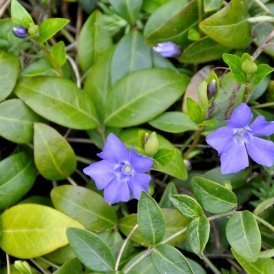Groundcovers are useful for covering large areas in the landscape. They can also be useful for solving specific landscaping problems, like replacing grass in shady locations, providing erosion control on steep slopes, and providing cover in spaces where it's difficult to mow. The trick to using groundcovers effectively is choosing the right one for the spot.
Good Places for Groundcovers
Places that are hard to mow, in deep shade, or areas seldom seen are all good candidates for groundcovers. Here are some examples of where they are commonly used:
- slopes and steep inclines
- under trees or tall shrubs
- in spaces between buildings or up next to the house
- dry, wet, or difficult areas where nothing else wants to grow
Choosing Groundcovers
When you're looking for a good groundcover, let your landscaping needs to define your choices. Focus on the plants that will suit your garden best by assessing your needs:
- To get the best performance from a groundcover, you have to give it the growing conditions it needs. Is your site shaded or in full sun? Is it moist or dry? Look for plant choices that are well adapted to your site conditions-sun, shade, water, soil type, heat and hardiness. In general, plants that spread by runners or stolons (underground stems) will fill in areas more quickly than plants that form clumps.
- Do you want bold or fine texture? How important are flowers? When it comes to selecting a ground cover based on appearance, you should make leaf texture and color the highest priority. In most species (there are exceptions), the flowers are merely a short-term bonus. Instead of focusing on flower color, consider the overall characteristics and seasonal interest.
- Do you need something that is tall, or a low-growing species that hugs the ground? For example, ground covers and spring bulbs make great companions as long as the ground cover isn't so tall it overshadows them, or so short that it doesn't help camouflage dying leaves.
- Don't forget maintenance. Weed control is a must until your ground cover is fully established. Mowing tolerance is important, too, if you will routinely be mowing near the area. Depending on your situation, you may also need to consider foot traffic. Many groundcovers can be left alone once they become established. Others may need occasional or even annual shearing to keep them looking and performing their best.
Grounder Covers for Special Situations
Ground covers should be selected for their seasonal interest as well as for their use. They are often chosen to solve a particular problem and planted in a difficult spot where other plants will not grow. The following list is by no means exhaustive. In fact, anything that grows semi-quickly and covers a large area can be considered a groundcover. Some of the plants on this list can become invasive, so contact local nurseries or your local Cooperative Extension Service for a list of groundcovers recommended for your area.
Dry, Shady sites (areas under shade trees, under eaves, and on shaded slopes)
- bugle-weed (Ajuga reptans)
- common periwinkle (Vinca minor)
- English ivy (Hedera helix)
- Epimediums (Epimedium spp.)
- Japanese pachysandra (Pachysandra terminalis)
- lilyturfs (Lirirope spp.)
- wintercreeper (Euonymus fortunei)
Sunny Sites (including slopes)
- carpet junipers* (Juniperus horizontalis)
- cotoneaster* (Cotoneaster spp.)
- creeping thymes (Thymus serphllum)
- crown vetch* (Securigera varia)
- day lilies* (Hemerocallis spp.)
- English ivy*(Hedera helix)
- maiden pinks (Dianthus deltoides)
- mock strawberry (Duschesnea indica)
- perennial candytuft (Iberis sempervirens)
- wintercreeper (Euonymus fortunei)
- wooly thyme (Thymus pseudolanuginosus)
Shade or Partial Shade
- bugle-weed (Ajuga reptans)
- ginger (Asarum canadense)
- goutweed (Aegopodium podagraria)
- lily-of-the-valley (Convallaria majalis)
- spotted dead nettle (Lamium maculatum)
- stonecrop (Sedum spp.)
Wet Sites
- astilbes (Astilbe spp.)
- bunchberry (Cornus spp.)
- creeping jenny (Lysimachia nummularia)
- forget-me-not (Myosotis spp.)
- heather (Erica spp.)
- hostas (Hosta spp.)
- lady's mantle (Alchemilla mollis)
- mint (Mentha spp.)
- sweet woodruff (Galium odoratum)
*These plants tend to spread quickly, and have deep enough roots to really hold the soil.
